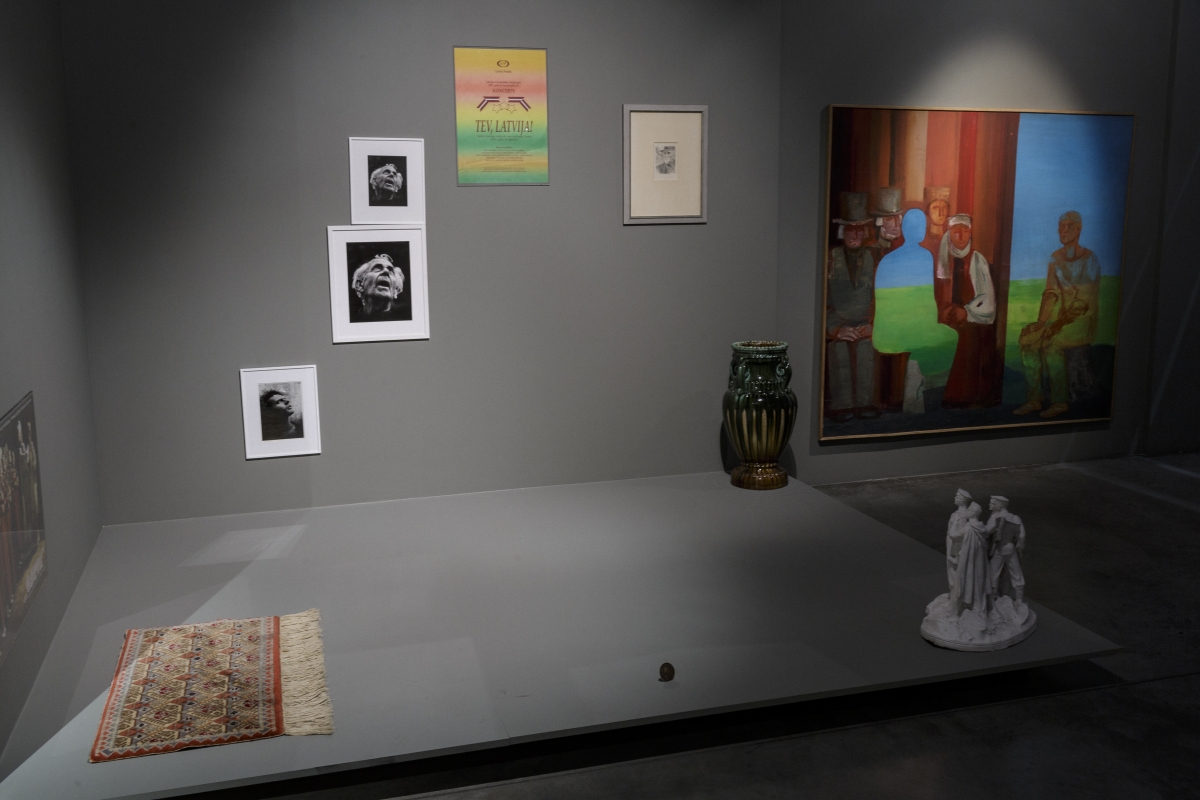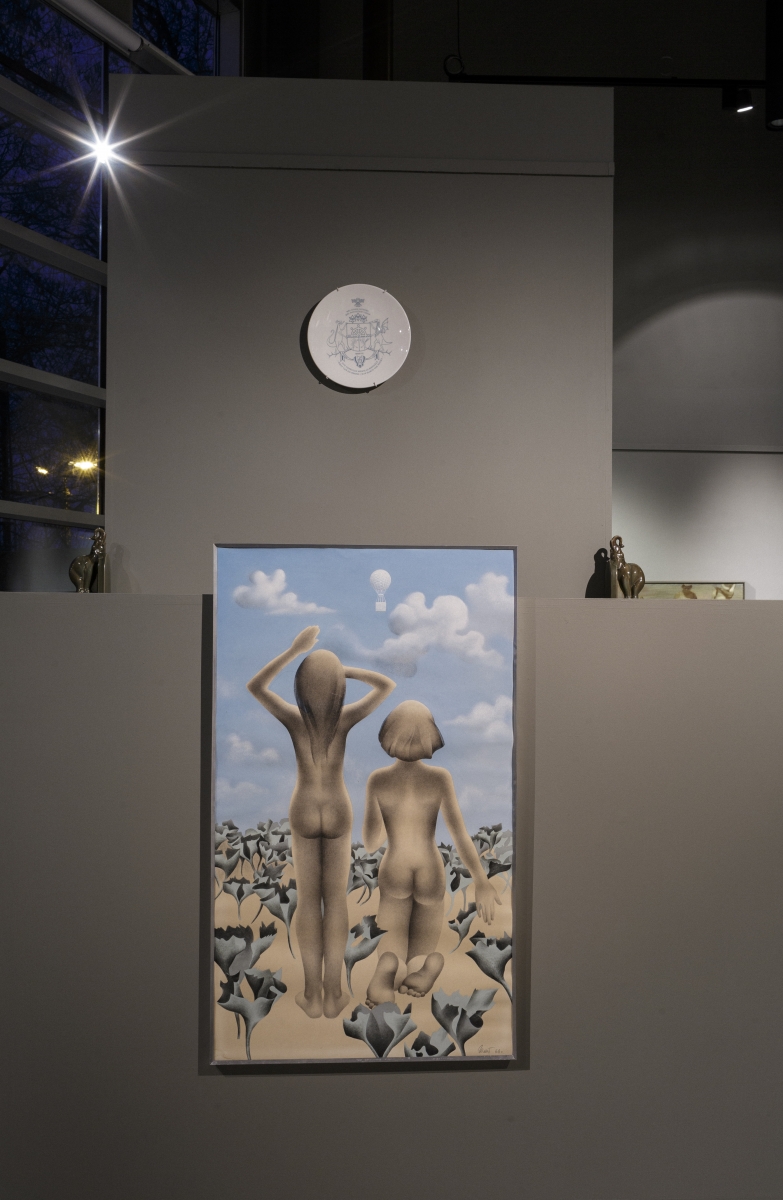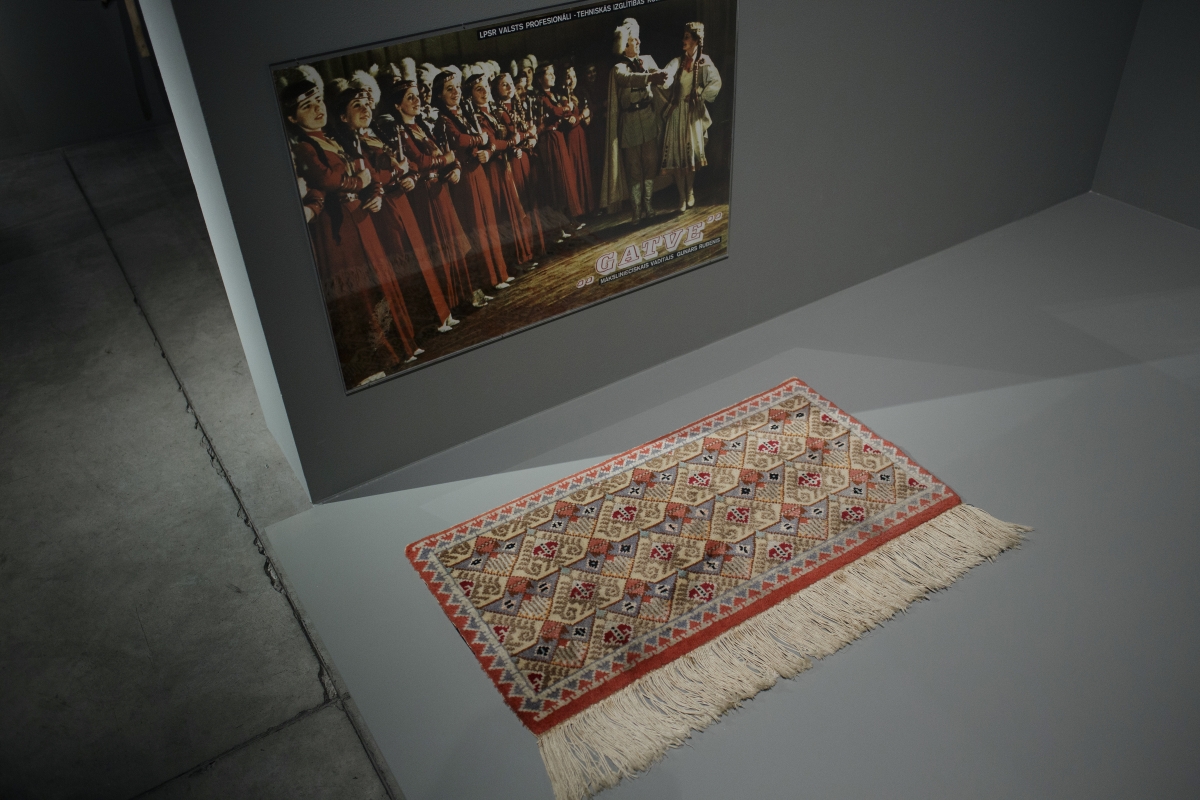
‘National Pavilion’, exhibition view, Mūkusala Art Salon, Riga 2018/19. Photo: Andrejs Strokins
A review of the Mūkusala Art Salon exhibition ‘National Pavilion’, 22.11.2018-19.01.2019
In November 2018, the Mūkusala Art Salon in Riga opened another of its rather frequent collection shows. The task is usually assigned to one of the ‘in-house’ curators, and this time being no exception, the show entitled ‘National Pavilion’ was curated by Valts Miķelsons.
Miķelsons is a rather enigmatic curator. Working at the Mūkusala Art Salon, a privately funded venue in Riga which hosts shows from the collection of the owners Jānis and Dina Zuzāni and contemporary exhibitions, Miķelsons acts with a kind of freedom that is difficult to describe. One would suspect a private collection and an art salon based on it would be rather boring, in the meaning of ‘salonish’. But even though the Mūkusalas Art Salon collection’s exhibition ‘TOP in formation’ at the Latvian National Art Museum (2017) was not liked by critics and loved by the public, their exhibition policy has nevertheless more than once given me reason to refer to it as exemplary. Funded privately, independent of public funds, the gallery has never fallen into the trap of the infamous curated programme. Their range of artists, topics and just the method of making exhibitions does not really fit in with any contemporary tactic of running an exhibition space: nor, for that matter, is it really in line with traditional museological trends. I would not call it ‘salonish’, but it is not contemporary either. And Miķelsons has found he fits into this cocktail rather well.
Working at Mukusala since 2012, he started with his art critic’s blog ‘Voltmeter’ in 2012 (discontinued in 2014). And because I have a fondness for special forms of criticism, he caught my eye with his collages ‘In Three Images’ on Facebook, which were a form of critical pictorial commentary on plays and exhibitions. His première as a curator in 2015 was called ‘Spam’, and was based on the posters in the Zuzāns collection. It was followed by ‘Goal Dept’ (2016), ‘The Golden Years’ (2017), and then, in my opinion, the boldest take on the collection, the exhibition ‘Porno’ (February 2018). In November 2018, Miķelsons’ fifth collection show at Mūkusala opened, entitled ‘National Pavilion’.

‘National Pavilion’, exhibition view, Mūkusala Art Salon, Riga 2018/19. Photo: Andrejs Strokins

‘National Pavilion’, exhibition view, Mūkusala Art Salon, Riga 2018/19. Photo: Andrejs Strokins
A moment of metaphorical inspiration
Despite being based on a remarkably wide-ranging collection, none of the shows tried to take an art historical position. But then it is not easy to say what position the exhibitions took. From the way the shows are put together, it looks at first glance like a mockery of contemporary exhibition design. The infamous question whether the fire extinguisher is part of the show or not, is solved by the fact that the towel dryer is marked on the exhibition map as a piece of art, whereas the fire extinguisher, which fits very well with the tight red ratchet straps between the columns in the gallery, does not.
Due to the shape of the frame surrounding a naive portrait of Putin hanging over the dryer (Ojārs Skadiņš’ Portrait of the President of Russia, Vladimir Putin, 2010), the forms of the towel dryer start to look like Baroque decor. ‘Let’s call it a moment of metaphorical inspiration,’ Miķelsons himself comments. ‘It feels as if Putin is making fun of everybody, and so it seems appropriate to make fun of him as well. That is sort of the point of the whole show … OK, if you want my take, then it looks like a ribcage,’ Miķelsons continues when I don’t give up.
Being the only readymade in the exhibition, and the only exhibited object that does not belong to the collection, the towel dryer is like the key to Miķelsons’ approach. First, it is not necessarily important whether the images and other objects in the exhibition are art. If it stopped there, it would be a rather Classical show, maybe about the truthfulness of art, for example. But it goes one step further: as it turns out, even the initial intention behind the artworks, their meaning, is to a large extent neglected. They are treated as material for a collage, which in the current case is on the topic of nationalism in the era of post-truth.
Miķelsons points to a vase in the exhibition that has neither an author nor a date. To me, the vase looked like a mockery of the growth in popularity that ceramics has suddenly had in the contemporary art field: a big vase as a pointless readymade or found object per se. Backed up by Jūlijs Straume’s little carpet (from the 1930s), all the elements seemed to be there. At least in the Estonian art field, ceramics and tapestry the way they were taught and thought of in the 1970s and 1980s are making a huge comeback. But Miķelsons says that part of the reason why the vase is in the exhibition is that it has no date. ‘It could have been made either in the Thirties, the Fifties, or even ten years ago. That fits well with many of the things I’m thinking about,’ and that’s definitely not art history.
In hindsight, it seems obvious, as another topic Miķelsons refuses to relate to is museology. When talking about aspects of his scenography and choice of works, the curator definitely had fun; but that is pretty much all there is as far as the collection and its specific cultural historic position are concerned. He denies any conscious attempt to reflect on the collection as such, or on the way the exhibitions of museums are put together. ‘I believe the National Art Museum has to show what ought to be shown, but I like it very much that I can show what I like to show here,’ said Miķelsons, and in what followed, he rejected all my claims about him having a rather particular take on the collection by intentionally choosing and combining ceramics, paintings, drawings, medals, posters and sculptures from very different periods and styles all into one show, and treating the collection like a cabinet of curiosities. Our conversation on that topic ended with Miķelsons withdrawing from the topic with a shake of the head, as it would be a forced line of thought to continue on. ‘An exhibition of the works in the collection, and everything that is happening in Mūkusala, for that matter, in a way, is about promoting the collection and making it available. But apart from that …’
Sure, I know I’m free to interpret, but knowing the curator personally rather well, and even having written some articles together with him, as the more devoted ‘Echo Gone Wrong’ readers might know, I felt helpless. I did not want to interview Miķelsons to get a comment on his point of view, I wanted to find approval for my interpretation, and hoped he would back me up with some facts and comments that would make it more thorough.

‘National Pavilion’, exhibition view, Mūkusala Art Salon, Riga 2018/19. Photo: Andrejs Strokins

‘National Pavilion’, exhibition view, Mūkusala Art Salon, Riga 2018/19. Photo: Andrejs Strokins
The bird in the top left-hand corner
The exhibition’s initial topic is post-truth, and as the Baltics have just had their centenary year, it was quite obvious that post-truth has to be looked at in a national context, and since the Latvian national pavilion by Miķelis Fišers at the Venice Biennale in 2017 was also dedicated to post-truth, it all came together. Fišers himself is present in the exhibition, with a ceramic plate that has the coat of arms of invading alien reptiles painted on it. Hanging high as if over a fireplace, there are porcelain bookends in the shape of elephants (Kuznetsov Factory 1934-1940) saluting the scenery on the mantelpiece below, and between it all is a painting of two children looking into the great beyond (Alberts Goltjakovs’ Dreams, 1968). It all looks like a composition for an independence war memorial from the 1930s. On the other side of the wall is the ribcage of Putin described above. Straightforwardly literal situations like this are rather common in the exhibition, and when one trusts the curators, and I found no reason not to, literariness is exactly the way the exhibition should be looked at. So, while Putin seems to be making fun of everybody, and we still have the freedom here to make fun of him, the question who laughs last remains.
Hanging on the red ratchet straps stretched between columns in the gallery, are posters by Sigismund Vidbergs. Presumably teaching material for a history class, they are supposed to be perceived as depictions of truth. To underline this, Miķelsons has exhibited one of the posters twice, as he did with Gunārs Binde’s famous photographic portrait of the theatre director Eduards Smiļģis. Photography is not only a depiction of reality; it is also endlessly reproducible, just like a scientific experiment that is true, due to its being repeatable. Cultural history has to be collected and recorded so that it can be researched, systematised, and, most importantly, taught, and not just told as a story.
Kristīne Luīze Avotiņa paints, and apparently also perceives, the world as an utterly positive and colourful place, as is depicted in her painting Pelican (2012). Although Miķelsons himself is incapable of taking such a view, he wanted it to be in the exhibition. The fact that the rather small work is hanging approximately 2.5 metres high is not in any way significant, according to the curator. I assume it is significant that underneath it is Arvīds Strauja’s Fairy-Tale Motif (1939), with a peasant soldier on the coast carrying a sword and a snake crawling out of a cave. Might one see here the symbolism of the eagle and the serpent, that is, good versus bad, where the pelican is substituted for the eagle? Be that as it may, the conflict between the serpent and the peasant who has drawn his sword seems to be inevitable, and isn’t that the way most of us perceive our geopolitical situation, as opposed to Avotiņa’s positive attitude? At the same time, I am sure Miķelsons would deny any relevance in the fact that both works come across as rather naive, not to say dilettantish.
The contradiction that stops me following Miķelsons’ lead of metaphors lies in the vast use of contemporary exhibition design conventions, which I cannot stop myself seeing as anything but ironic. Works hanging extremely high, especially close to a corner, or very low, like Carmel Skutelsky’s photograph Untitled (sic!), are typical of contemporary exhibition design. Whereas objects that are exhibited in this way do not usually have any meaning other than being part of an abstract design. The more anonymous the object, the better: a metal or wooden rod, a found photograph, etc. Seeing a painting of a pelican exhibited like this by a curator and fellow critic, who I know has seen internationally many more pointless displays than I ever will, it is rather difficult to view the gesture as just a random choice that is in no way more significant than hanging a painting at eye level would be.

‘National Pavilion’, exhibition view, Mūkusala Art Salon, Riga 2018/19. Photo: Andrejs Strokins
Elegant gentleman
In the accompanying curatorial text, Miķelsons writes that the exhibition ‘proposes playing around with images and meanings in a space which can still be considered freedom. It is a space where the path between a large flag and a small flag remains both a private and a collective decision.’ The big flag is a 20-by-10 ten-metre flag hoisted on a 60-metre-high pole, as part of the Latvian centenary, on the bank of the River Daugava. The little flag is Ivars Poikāns’ print ‘Flag in the Bottom”’, (1987), which Miķelsons uses as a reference to Trump’s alleged phrase ‘shithole countries’. ‘In Latvia, you can poke fun at things and look at them in comfort and from a position of reasonable safety,’ commented Miķelsons. But at the same time he is rather critical of the bourgeois family idyll in Auseklis Baušķenieks’ painting Afternoon (1986). Sitting in their futuristic spherical-shaped home, the husband comes across as being rather cynical towards everything. As were the flâneurs, who were quite recently (if not still) very topical in contemporary art, and are present in the exhibition, depicted on a 1936 poster The Elegant Gentleman Fashion Store. We intellectuals tend to laugh at Trump voters. At least, I could not stop myself smiling in front of a display of posters from the 1925 municipal elections which addressed local Orthodox Russians, Catholic Poles, and united workers. The bourgeois family, also enclosed in their cynical ironic bubble, cease to notice that the first words spoken by their children are ‘Lenin’ and ‘Stalin’, as articulated by two little porcelain figures of children from the Kyiv Porcelain Factory entitled ‘First Word’ (early 1950s).
Politics, according to Miķelsons, ‘is a way to imagine various untruths’. As is art. It is only that in the time and age of post-truth, contemporary art quite often sounds like ‘the programmes of tradition-honouring ultranationalists’. The rise of esoteric, criticism of technology and Western thought in contemporary art exhibitions is noticeable. At the same time, leftist criticism can be ‘entirely indistinguishable from the alternative facts propagated by despots seeking to discredit and divide democratic societies’. Sharing the straight-faced audacious lies of Trump or Putin ‘merely helps the authoritarian agenda, while having fun at the same time’. And apolitical aestheticism ‘has historically served as a soft power tool for both democratic internationalism and the kleptocrats of the world’.
Taking this into account, ‘National Pavilion’ is not so much a mockery of the centenary as it might seem. First of all, it looks like a celebration of the freedom we have here in the Baltics. But what to make of the exhibition remains a bit of a puzzle to me, for like so much of what is happening in the Mūkusala Art Salon, it is beyond the reach of standard art criticism. According to the curator, ‘National Pavilion’ is not a particular take on the collection, nor on collection exhibitions, and neither is it a comment on contemporary exhibition design, which are topics I would write about if I had not given the curator a chance to explain himself. This does not mean that the exhibition cannot be interpreted according to these typical topics of art criticism, it is still an art exhibition, but doing so would mean sliding into a political extreme, and ignoring the possibility of centrism, the survival of which Miķelsons is fighting for.
The exhibition could be disassembled into several small narratives, most of which are concentrated on one particular wall or section of the gallery. One of these narratives is a rather small corner piece of the gallery wall that is quite often left blank, but this time it has three works hanging close to each other. Pushed into the corner on the right is Mārtiņš Ozoliņš’ On Guard (1940). Two figures in hooded robes with torches. When pointing to it, Miķelsons refers to Pegida, thereby asking us to admit that it is pretty much impossible to perceive the work as it would have been perceived in its original context in 1940. He uses it just as an image, as a depiction, and not so much as a work of art with an art historical context. And sorry, it really does look like a Ku Klux Klan ceremony. On the left of the triptych is Māris Ārgalis’ City Dwellers (undated). It depicts a worker, looking at him from a dynamic street photography angle, walking in the centre of Riga, I assume, wearing his factory uniform and a worker’s cap. Between the extreme right and the ideological left hangs Zigurds Zuze’s original drawing for the inside cover of the epic poem ‘Lāčplēsis’ from 1957. It depicts an ageing wooden fortification, that is, the unavoidable stand-off between extremists.
I would compare Miķelsons’ approach to nationalism and post-truth, and to the works in the exhibition, to his series of criticism ‘In Three Images’ that I mentioned at the beginning of the article. The images do not necessarily have anything to do with each other as regards style or content, and they are significant in themselves only insofar as they articulate the characteristics or topics Miķelsons wants to draw attention to. In the end, I think the exhibition is really just playing around with images and meanings, pretty much ignoring the fact of being an art exhibition.

‘National Pavilion’, exhibition view, Mūkusala Art Salon, Riga 2018/19. Photo: Kristīne Madjare

‘National Pavilion’, exhibition view, Mūkusala Art Salon, Riga 2018/19. Photo: Kristīne Madjare






























